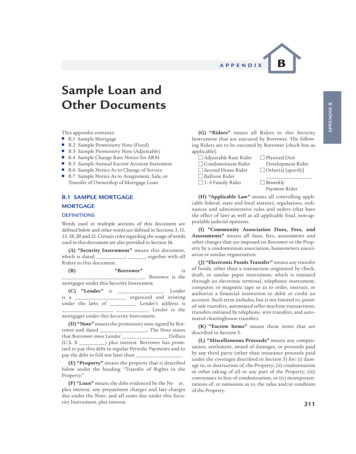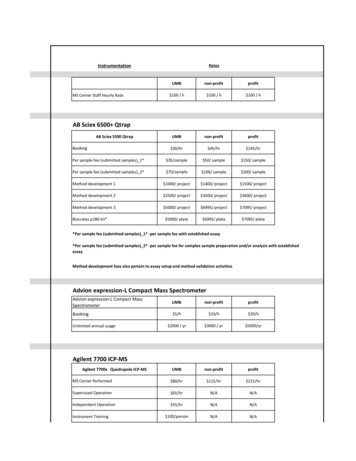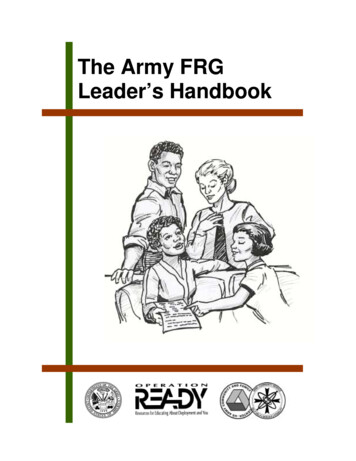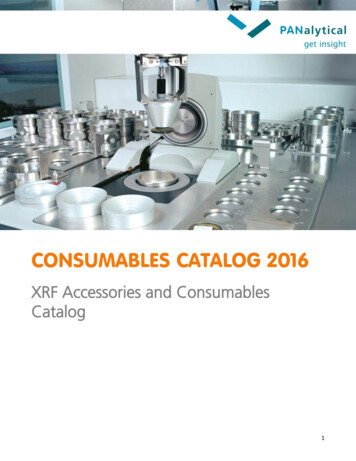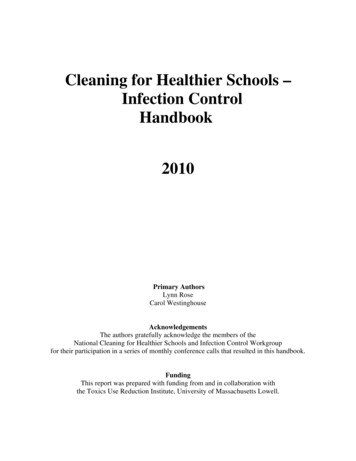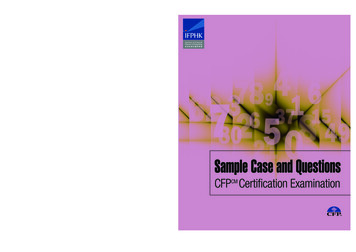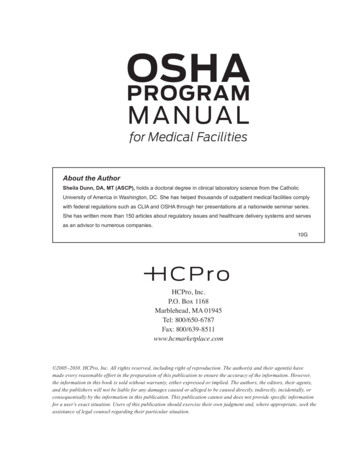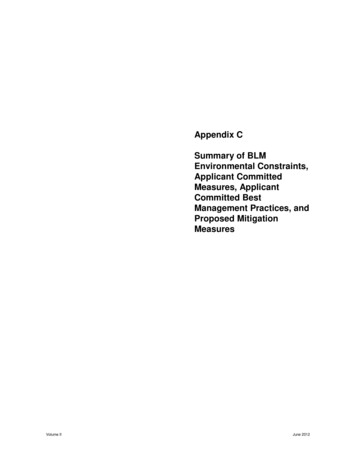
Transcription
Appendix CSummary of BLMEnvironmental Constraints,Applicant CommittedMeasures, ApplicantCommitted BestManagement Practices, andProposed MitigationMeasuresVolume IIJune 2012
Chokecherry and Sierra Madre Final EISAppendix Table C-1C-1Appendix Table C-1Summary of BLM Environmental Constraints1Resource AreaResource ConcernProtection MeasureApplication to ion2TypeAuthority/SourceCultural – HistoricTrailsWithin either 0.25-mile or the visualhorizon (whichever is closer) of a culturalproperty/ historic trails.No surface disturbing activities. Management actions resulting in visual elements that diminish the integrity ofthe property’s setting will be managed in accordance with the Wyoming State Protocol and BMPs.Yes4Recreation SitesWithin 0.25-mile of developed andundeveloped recreation sites.Lands closed to operation of public land laws.Yes4Yes4Yes412008 Rawlins RMP ROD.Soils – SlopesSteep slopes 25 percent.Surface disturbance will be prohibited. No turbines, staging or substations.Yes5Yes5Yes51Wyoming BLM MitigationGuidelines.Special ManagementAreas – DesignatedAreasDesignated areas part of the NationalLandscape Conservation System (e.g.,Continental Divide National Scenic Trail[CDNST]).Lands will be excluded from wind energy site monitoring and testing and development on lands on which windenergy development is incompatible with specific resource values. (0.25-mile swath centered on the trail)n/aYes4Yes1Wind EnergyProgrammatic EIS RODPolicies and BMPs.Water – EphemeralChannelsWithin 100 feet from the inner gorge ofephemeral channels.Avoidance areas for surface-disturbing and disruptive activities and linear crossings. Only those actions withinareas that cannot be avoided and that provide protection for the resource identified will be approved.No5No5Yes512008 Rawlins RMP ROD.Water – FloodplainsIdentified 100-year floodplains.Surface disturbing activities will be avoided. Only those actions within areas that cannot be avoided and thatprovide protection for the resource identified will be approved.NoNoYes12008 Rawlins RMP ROD.Water – PerennialWaters, Springs,Wetlands, RiparianWithin 500 feet of perennial waters,springs, and wetland and riparian areas.Surface disturbing activities will be avoided. Only those actions within areas that cannot be avoided and thatprovide protection for the resource identified will be approved.512008 Rawlins RMP ROD;Wyoming BLM MitigationGuidelines; ExecutiveOrders (EOs) 11990 and11988.Water – UnstableAreasUnstable areas (such as landslides, slopes 25 percent, slumps, and areas exhibitingsoil creep).Surface disturbing activities will be avoided. Reclamation practices and BMPs will be applied as appropriatefor surface disturbing activities.NoNoYes12008 Rawlins RMP ROD.Water – WetlandsWetlands identified on National WetlandsInventory (NWI) or proper functioning6condition (PFC).No disturbance.NoNoYes1EOs 11990 and 11988.Wildlife – AmphibiansIdentified 100-year floodplains; within500 feet of perennial waters, springs,wells, and wetlands; and within 100 feet ofthe inner gorge of ephemeral channels.Surface disturbing and disruptive activities will be avoided.NoNoYes12008 Rawlins RMP ROD.Wildlife – FishWaterbodies that potentially support fishfor a portion of the year.Design road crossings to simulate natural stream processes.NoNoYes12008 Rawlins RMP ROD.Wildlife – Raptors825 feet of active raptor nests (ferruginoushawks, 1,200 feet).Well locations, roads, ancillary facilities, and other surface structures requiring a repeated human presencewill not be allowed. Distance may vary depending on factors such as nest activity, species, naturaltopographic barriers, and line-of-sight distances.YesYesYes12008 Rawlins RMP ROD.Wildlife-ColumbianSharp-tailed Grouse0.25 mile to 1 mile of an occupied orundetermined Columbian sharp-tailedgrouse lek.High-profile structures (e.g., buildings, storage tanks, overhead powerlines, wind turbines, towers, andwindmills) would be authorized on a case-by-case basis from one-quarter mile to 1 mile of an occupiedgreater sage-grouse and sharp-tailed grouse lek.NoNoYes12008 Rawlins RMP ROD.Wildlife – GreaterSage-grouseInside Core Areas: 0.60 mile NSU fromlek perimeter (includes occupied andundetermined leks).Outside Core Areas: 0.25 mile NSU fromlek perimeter (includes occupied andundetermined leks).Surface disturbing activities or surface occupancy is prohibited or restricted.YesYesYes1BLM IM No. WY-2012-019Volume IINo4,5YesYes12008 Rawlins RMP ROD;Wyoming BLM MitigationGuidelines; Wind EnergyProgrammatic EIS RODPolicies and BMPs.No4,5YesJune 2012
Chokecherry and Sierra Madre Final EISAppendix Table C-1C-2Appendix Table C-1Summary of BLM Environmental Constraints1Resource AreaResource ConcernProtection MeasureApplication to ion2TypeAuthority/SourceWildlife – GreaterSage-grouseInside Core Areas.Limit development to one disturbance location per 640 acres. Cumulative value of one location and existingdisturbance to not exceed 5 percent of sagebrush habitat within 640 acresNoNoYes1BLM IM No. WY-2012-019Wildlife – GreaterSage-Grouse0.25-mile to 1 mile of an occupiedsage-grouse lek.High-profile structures (e.g., buildings, storage tanks, overhead power lines, wind turbines, towers, andwindmills) will be authorized on a case-by-case basis.NoNoYes12008 Rawlins RMP ROD.Wildlife – GreaterSage-grouseInside Core Areas: Within 0.60-mile of theperimeter of an occupied or undeterminedgreater sage-grouse lek.Outside Core Areas: Within 0.25-mile ofthe perimeter of an occupied orundetermined greater sage-grouse lek.Disruptive activities are restricted between 6:00 p.m. and 9:00 a.m. from March 1 to May 20.NoNo7Yes22008 Rawlins RMP ROD;BLM IM No. WY-2012019.Wildlife – GreaterSage-grouseInside Core Areas: In suitable greatersage-grouse nesting and earlybrood-rearing habitat.Outside Core Areas: In suitable greatersage-grouse nesting and early broodrearing habitat within 1) mapped habitatimportant for connectivity, or 2) within2 miles of any occupied or undeterminedlek.Surface disturbing and/or disruptive activities are prohibited or restricted from March 1 – July 15.NoNo7Yes2BLM IM No. WY-2012019; 2008 Rawlins RMPROD.Wildlife – GreaterSage-grouseGreater sage-grouse delineated winterconcentration areas.Surface disturbing and/or disruptive activities in mapped or modeled greater sage-grouse winterhabitats/concentration areas that support Core Area populations, are prohibited or restricted fromNovember 15 – March 14.NoNo7Yes2BLM IM No. WY-2012019; 2008 Rawlins RMPROD.Wildlife – ColumbianSharp-tailed GrouseWithin 0.25-mile of the perimeter of anoccupied or undetermined Columbiansharp-tailed grouse lek.Surface disturbing activities or occupancy are prohibited. Disruptive activities are prohibited between6:00 p.m. and 9:00 a.m. from March 1 to May 20.NoNo7Yes22008 Rawlins RMP ROD.Wildlife – Barn OwlWithin 0.75-mile of barn owl nests.Surface disturbing and disruptive activities potentially disruptive are prohibited February 1–July 15.NoNo7Yes22008 Rawlins RMP ROD.No7Yes22008 Rawlins RMP ROD;Wyoming BLM MitigationGuidelines.77777Wildlife – Big GameBig game crucial winter range.Surface disturbing and disruptive activities will not be allowed during the period of November 15 to April 30.Disruptive activities will require the use of BMPs designed to reduce the amount of human presence andactivity during the winter months.No7Wildlife – Big GameBig game parturition areas.Surface disturbing and disruptive activities will not be allowed during the period of May 1 to June 30.No7No7Yes22008 Rawlins RMP ROD;Wyoming BLM MitigationGuidelines.Wildlife – BurrowingOwlWithin 0.75-mile of burrowing owl nests.Surface disturbing and disruptive activities potentially disruptive are prohibited April 15–September 15.No7No7Yes22008 Rawlins RMP ROD.Wildlife – Cooper’sHawkWithin 0.75-mile of Cooper’s hawk nests.Surface disturbing and disruptive activities potentially disruptive are prohibited April 1–July 31.No7No7Yes22008 Rawlins RMP ROD.Wildlife – FerruginousHawkWithin 1-mile buffer of ferruginous hawknests.Surface disturbing and disruptive activities potentially disruptive are prohibited March 1–July 31.No7NoYes22008 Rawlins RMP ROD.Wildlife – Golden EagleWithin 1-mile buffer of golden eagle nests.Surface disturbing and disruptive activities potentially disruptive are prohibited February 1–July 15.No7No7Yes22008 Rawlins RMP ROD.Wildlife – GoshawkWithin 0.75-mile of Goshawk nests.Surface disturbing and disruptive activities potentially disruptive are prohibited April 1–August 31.No7No7Yes22008 Rawlins RMP ROD.No7Yes22008 Rawlins RMP ROD.No7Yes22008 Rawlins RMP ROD.No7Yes22008 Rawlins RMP ROD.Wildlife –Great-Horned OwlWithin 0.75-mile of great-horned owlnests.Surface disturbing and disruptive activities potentially disruptive are prohibited February 1–July 15.No7Wildlife – KestrelWithin 0.75-mile of kestrel nests.Surface disturbing and disruptive activities potentially disruptive are prohibited April 1–July 31.No7No7Wildlife – Long-EaredOwlVolume IIWithin 0.75-mile of long-eared owl nests.Surface disturbing and disruptive activities potentially disruptive are prohibited March 1–July 31.7June 2012
Chokecherry and Sierra Madre Final EISAppendix Table C-1C-3Appendix Table C-1Summary of BLM Environmental Constraints1Resource AreaResource ConcernProtection MeasureApplication to ion2TypeAuthority/SourceWildlife – MerlinWithin 0.75-mile of Merlin nests.Seasonal wildlife stipulation April 1–July 31.No7No7Yes22008 Rawlins RMP ROD.Wildlife – MountainPloverPotential and occupied habitat Mountainplover.Habitat will be avoided where practical. All surface-disturbing activities will be restricted from April 10 toJuly 10. Additional protection measures will be applied if this area is later determined to be within occupiedhabitat. Occupied habitat is defined as areas where broods and adults have been found.No7No7Yes22008 Rawlins RMP ROD.Wildlife – NorthernHarrierWithin 0.75-mile of northern harrier nests.Surface disturbing and disruptive activities potentially disruptive are prohibited April 1–July 31.No7No7Yes22008 Rawlins RMP ROD.Wildlife – OspreyWithin 0.75-mile of osprey nests.Surface disturbing and disruptive activities potentially disruptive are prohibited April 1–July 31.No7No7Yes22008 Rawlins RMP ROD.No7Yes22008 Rawlins RMP ROD.Wildlife – PeregrineFalconWithin 0.75-mile of peregrine falcon nests.Surface disturbing and disruptive activities potentially disruptive are prohibited March 1–July 31.No7Wildlife – PrairieFalconWithin 0.75-mile of prairie falcon nests.Surface disturbing and disruptive activities potentially disruptive are prohibited April 1–July 31.No7No7Yes22008 Rawlins RMP ROD.Wildlife – RaptorDefined raptor and game bird winterconcentration areas.Activities or surface use will not be allowed from November 15 to April 30.No7No7Yes2Wyoming BLM MitigationGuidelines.Wildlife – RaptorRaptor nesting habitat.Activities or surface use will not be allowed from February 1 to July 31.No7No7Yes2Wyoming BLM MitigationGuidelines.Wildlife – RaptorsWithin 0.75-mile of other raptor nests.Surface disturbing and disruptive activities potentially disruptive are prohibited February 1–July 15.No7No7Yes22008 Rawlins RMP ROD.No7Yes22008 Rawlins RMP ROD.No7Yes22008 Rawlins RMP ROD.Yes22008 Rawlins RMP ROD.Wildlife – Red-TailedHawkWithin 0.75-mile of red-tailed hawk nests.Surface disturbing and disruptive activities potentially disruptive are prohibited February 1–July 15.No7Wildlife – Screech OwlWithin 0.75-mile of screech owl nests.Surface disturbing and disruptive activities potentially disruptive are prohibited March 1–July 31.No7No7Wildlife –Sharp-Shinned HawkWithin 0.75-mile of sharp-shinned hawknests.Surface disturbing and disruptive activities potentially disruptive are prohibited April 1–July 31.No7Wildlife – Short-EaredOwlWithin 0.75-mile of short-eared owl nests.Surface disturbing and disruptive activities potentially disruptive are prohibited March 1–July 31.No7No7Yes22008 Rawlins RMP ROD.Wildlife – Swainson’sHawkWithin 0.75-mile of Swainson’s hawknests.Surface disturbing and disruptive activities potentially disruptive are prohibited April 1–July 31.No7No7Yes22008 Rawlins RMP ROD.Wildlife – WesternYellow-billed CuckooWithin 0.5 mile radius yellow-billed cuckoonest.Seasonal wildlife stipulation April 15–August 15.No7No7Yes22008 Rawlins RMP ROD.1234567Sources of information for application of stipulations for private and state lands include Applicant Proposed Alternative and BLM Response Letter (April 23, 2010), PCW Response and Data on BLM Alternatives (December 2009), and the Plan of Development for theChokecherry and Sierra Madre Wind Energy Project (January 12, 2012).1 Restriction; 2 Seasonal.As indicated in PCW’s submittal entitled Applicant Proposed Alternative and BLM Response Letter (April 23, 2010).Applicant imposes more restrictive measures or applies measure to a specific area, see summary table of PCW ACMs.Per the PCW Response and Data on BLM Alternatives (December 2009) footnotes to Alternatives Summaries #18, “No Surface Uses (NSUs), as provided by BLM, were avoided to the extent practicable; however, some NSUs could not be completely avoided in asmall number of discreet instances (mainly ephemeral streams, slope, and perennial streams/springs/wetlands/riparian). An example of an exception to the NSUs is where a turbine is located in an area that cannot be accessed without crossing an ephemeral stream. Ifit is determined that the stream is a Water of the U.S., then a Section 404 permit will be obtained thereby allowing an access road to be constructed. Another example is the slope criteria. The accuracy of the digital terrain model used for this analysis is insufficient formicro-siting. Engineering judgment was used to determine in a limited number of cases that it may be possible to grade a resource road to design criteria.”See Chapter 8.0, Glossary.Per the PCW Response and Data on BLM Alternatives (December 2009) footnotes to Alternatives Summaries #10, “seasonal timing restrictions were not applied to construction activities on private land.”Volume IIJune 2012
Chokecherry and Sierra Madre Wind Energy ProjectProject Plan of DevelopmentAppendix C.Applicant Committed MeasuresAppendix Table C-2. Summary of Applicant Committed MeasuresItemA-1-01Environmental ResourceESA, sensitive species,and other wildlife andfish speciesA-1-02Avian and Bat Species,Golden and Bald EaglesA-1-03Greater Sage-grouseA-1-04Wildlife HabitatManagement AreasA-1-05Mule DeerA-1-06Colorado River Fishes –bluehead sucker,flannelmouth sucker,roundtail chub, ColoradoRiver cutthroat troutFish species, amphibianspecies, other streamobligates; water qualityA-1-07A-1-08Other wildlife speciesA-1-09Wildlife StipulationsA-1-10A-1-11Wildlife StipulationsAvian and BatMonitoringApril 10, 2012Applicant Committed MeasureSite-specific surveys and/or monitoring for ESA threatened andendangered species, BLM sensitive species and other wildlifeand fish species will take place during each phase ofconstruction. Survey and monitoring approaches will bedeveloped in coordination with USFWS, BLM, and WGFD andwill be identified in the site-specific PODs developed for eachconstruction right-of-way grant.PCW will develop an Avian Protection Plan (APP), a BatProtection Plan (BPP) and an Eagle Conservation Strategy (ECS)to identify measures to avoid, minimize, and mitigate projectimpacts through siting, operations, and monitoring.PCW will comply with EO 2011-5 and commit to noconstruction activities within Wyoming’s SGCA as they areidentified in EO 2011-5 (Core Area Version 3 Map).PCW will not construct any facilities within portions of the RedRim-Grizzly WHMA and Upper Muddy Creek Watershed-GrizzlyWHMA that are within the Wyoming Sage-Grouse CoreManagement Area Version 3 Map (EO 2011-5).PCW will continue to coordinate with WGFD on ongoing muledeer monitoring efforts on the Ranch.PCW will continue to work with WGFD and BLM to developconservation and monitoring strategies for native fish species inthe Upper Muddy Creek watershed.PCW will monitor watershed and stream conditions throughoutthe Application Area to document hydrologic conditions andstream channel characteristics (see Appendix F – WatershedMonitoring Plan).PCW will continue to incorporate the outcome of site-specificsurveys to microsite infrastructure in order to avoid, minimize,or mitigate impacts to wildlife species.PCW will adhere to the timing and spatial stipulations andexception processes as they are described in the Project ROD.Timing and spatial stipulations will be used on public lands.PCW will develop a project Avian Protection Plan, BatProtection Plan and Eagle Conservation Strategy that will eachdescribe post-construction monitoring efforts for avian and batspecies.C-4
Chokecherry and Sierra Madre Wind Energy ProjectProject Plan of DevelopmentItemA-1-12Environmental ResourceWildlife Monitoring andSurveyA-1-13VegetationA-1-14Colorado butterfly plantand Ute ladies’-tressesorchidRevegetation andReclamationA-1-15A-1-16A-1-17Wetland ResourcesWetland ResourcesA-1-18Cultural ResourcesA-1-19Cultural shed ResourcesA-1-22Greater Sage-GrouseApril 10, 2012Applicant Committed MeasurePCW will continue to incorporate the outcome of site-specificsurveys to microsite infrastructure in order to avoid, minimize,or mitigate impacts to sensitive wildlife species.Vegetation datasets developed by PCW will be used duringproject design to identify sensitive vegetation types foravoidance, minimization or mitigation and to optimize thereclamation plans for each construction phase.Site-specific surveys for both plant species will be completedprior to surface disturbing activities in suitable habitat.PCW will develop detailed reclamation plans for each of theconstruction phases and right-of-way grants. These plans willconsider site-specific conditions and design considerations tomaximize reclamation success.Facilities would be sited to avoid and/or minimize impacts.Any construction that occurs in or adjacent to wetlands andstreams would use BMPs to protect surface water quality andminimize impacts to those resources.Class III inventories of all proposed disturbance areasassociated with the site-specific POD will be conducted prior toconstruction.All cultural resource identification, evaluation, and treatment,including as a result of unexpected discovery at such time thatconstruction has been permitted, will follow the stipulations ofthe Programmatic Agreement (PA) established for the project.In the event that fossils are discovered on public lands duringconstruction activities, PCW will suspend work in that area,have an on-call paleontologist review the fossils, and notify theBLM. PCW expects the significance of the discovery and theresulting course of action to be determined within 48 hours ofdiscovery.PCW has implemented a watershed monitoring program toevaluate potential impacts of project construction andoperations. PCW commits to continue watershed monitoringefforts for three years post-construction.PCW will work cooperatively with BLM and WGFD to performannual lek monitoring within the Ranch in accordance withapproved WGFD protocols during pre-construction,construction and for five years post-construction.C-5
Chokecherry and Sierra Madre Wind Energy ProjectProject Plan of DevelopmentItemA-1-23Environmental ResourceGreater Sage-GrouseA-1-24Greater Sage-GrouseA-1-25Avian Species includingBald and golden Eaglesand Greater SageGrouseWildlife includingGreater Sage-Grouse,Other Avian Species andSmall MammalsWildlife includingGreater Sage-Grouseand Bald and 1-32Wildlife includingGreater Sage-Grouseand Bald and GoldenEaglesWildlife includingGreater Sage-Grouseand Bald and GoldenEaglesWildlife includingGreater Sage-Grouseand Bald and GoldenEaglesWildlife includingGreater Sage-Grouseand Bald and GoldenEaglesGreater Sage-GrouseApril 10, 2012Applicant Committed MeasurePCW will work with BLM and private landowners to identifyfences that pose a significant collision risk to sage-grouse.Identified fences will be removed or marked as practicable. Todate PCW and TOTCO have removed over 10 miles of fence andhave marked an additional 16 miles of fence with reflective birddiverters.PCW will work with BLM and private landowners to evaluateproposed new fences and determine the risk of such fences tosage-grouse. If significant risk exists, new fence constructionwill be deferred where possible; if fences must be constructedthey will be marked with reflective bird diverters.Guy wires on meteorological towers will be marked withreflective bird diverters. To date PCW has marked all guy wireson Project meteorological towers with reflective bird diverters.PCW will work with private landowners to install metal meshescape ladders in water tanks that pose a risk to wildlifespecies. To date, PCW and TOTCO have installed metal meshescape ramps on many Ranch water tanks.PCW will work with BLM and private landowners to stabilizeand rehabilitate burned areas to promote the biologicalintegrity of the site and limit expansion of invasive species. In2010 PCW and TOTCO pursued stabilization and recovery of aburned area in the Chokecherry site with an emphasis on rapidrecovery and use of the area by sage-grouse and other species.PCW will work with private landowners and water right ownersto pursue water improvement conservation projects to benefitgreater sage-grouse and other wildlife species in accordancewith all applicable rules and regulations.PCW will work with private land owners to enhance fallowagricultural fields on the Ranch located east of the North PlatteRiver. Enhancements include vegetation treatments toimprove forage and cover for greater sage-grouse.To minimize habitat fragmentation PCW will work with BLMand private landowners to close unnecessary roadways andreclaim such roads where practicable.PCW will work with BLM and private landowners to control thespread of noxious and invasive plant species.PCW will work with private landowners to suspend the huntingof sage-grouse on private lands within the RanchC-6
Chokecherry and Sierra Madre Wind Energy ProjectProject Plan of DevelopmentItemA-1-33Environmental ResourceGreater Sage-GrouseApril 10, 2012Applicant Committed MeasurePCW will cooperate with agencies and private land owners toevaluate and implement predator control techniques to benefitsage-grouse as appropriate.C-7
Chokecherry and Sierra Madre Wind Energy ProjectPlan of DevelopmentAppendix Table C-2. Summary of Applicant Committed WTGsSubsRoadsCollection TLineApplies ToPrivateJurisdictionA-2-01CulturalHistoric Trails1 mile WTGs,0.25 mile surfaceof the OverlandTrailYYYYYNo,minimizecrossings,cross atright anglesA-2-02Lands andRealty City/TownLimitsLands andRealtyHomes/OccupiedBuildingsLands andRealty - ROWSetbackStructure base0.5 mile setbackYYYYYNoGreater of 5.5times totalstructure heightor 1,000 ft.setback5D from ROWboundaryYYYYNNoSetback only applies to "towers," term not defined inAct; PCW to apply setback to WTGs, overheadcollection, and transmission structures based on theheight of each structureNNYYNNoWaiver may be grantedItemA-2-03A-2-04April 10, 2012C-8Notes1 mile setback from the center of the Overland Trail aspresently mapped (2008 RMP/ROD) in all areas exceptthe following sections, where the BLM's RMPrequirement of 0.25 miles were used: T18N R87W S6;T18N R88W S1; T18N R88W S2; T18N R88W S4; T18NR88W S7; T18N R88W S9; T18N R89W S11; T18N R89WS12; T18N R89W S13; T18N R89W S14; and theunmapped Overland Trail alternative route located inT18N R88W S6, T18N R89W S1, T18N R89W S2, T18NR89W S11, and T18N R89W S10.Setback only applies to "towers," term not defined inAct; PCW to apply setback to WTGs, overhead
Chokecherry and Sierra Madre Wind Energy ProjectPlan of DevelopmentLands andRealty - WTGsA-2-07Lands andRealty - WTGsA-2-08Recreation TetonReservoirWater - NorthPlatte RiverA-2-09April 10, 2012RoadsCollection TLineA-2-06Greater of 5.5times totalstructure heightor 1,000 ft.setbackTower base 1.1times totalstructure heightfrom externalproperty linesTower base 1.1times totalstructure heightfrom any publicROWs1 mile boundaryWTGs of TetonReservoir1 mile high watermark WTGs ofthe North PlatteRiverSubsLands andRealty tateResourceConcernItemApplies ToPrivateJurisdictionYYYYYYes, exceptundergroundSetback applies to all above‐ground construction,underground appears permissible within setbackYYYYNNoSetback only applies to "towers," term not defined inAct; PCW to apply setback to WTGs, overheadcollection, and transmission structures based on theheight of each structureYYYYNNoSetback only applies to "towers," term not defined inAct; PCW to apply setback to WTGs, overheadcollection, and transmission structures based on theheight of each structureYYYYNNoWTG placement would be prohibited within one mileof the Teton Reservoir Recreation Site.YYYYYNo, avoid ifpossibleWTG placement would be prohibited within one mileof the ordinary high water mark of the North PlatteRiver.C-9
Chokecherry and Sierra Madre Wind Energy ProjectPlan of DevelopmentWildlife- SageGrouse CoreBreeding AreaApril 10, 2012RoadsCollection TLineA-2-11No developmentwithin Red RimGrizzly WHMAwithin theWyoming SageGrouse CoreManagementAreas Version 3Map (finalizedJune 29, 2010)No facilitieswithin theWyoming SageGrouse CoreManagementArea Version 3Map (finalizedJune 29, 2010)SubsWildlife - RedRim GrizzlyWildlifeHabitat teResourceConcernItemApplies ToPrivateJurisdictionYYYYYYesThe Wyoming Game and Fish Department’s (WGFD)Red Rim-Grizzly WHMA is approximately 37,630 acresin total, of which approximately 1,200 acres (3%) lieoutside Sage-Grouse Core Management Areas Version3. The area outside Sage-Grouse Core ManagementAreas Version 3 is located in the northeast corner ofthe Grizzly WHMA and is a part of or adjacent to MillerHill. PCW may locate facilities within this area of theGrizzly WHMA.YYYYYYesNo construction of any facilities (WTGs, roads,transmission lines, collector lines, substations, stagingareas, etc.) in Wyoming’s Sage-Grouse CoreManagement Areas Version 3 (finalized June 29, 2010).C-10
Chokecherry and Sierra Madre Wind Energy ProjectPlan of DevelopmentAppendix Table C-3. Applicant Committed Best Management PracticesItemResource ConcernA-3-01Air – Dust ControlA-3-02Air – Dust ControlMagnesium chloride may be applied, if necessary, for adequate dust suppression. These treatments wouldoccur on an as-needed basis, depending on weather conditions and the amount of traffic on the road.A-3-03Air – Dust ControlThe driving surface of all roads constructed for project access would be surfaced with gravel to furtherreduce potential dust emissions.A-3-04Air – Dust ControlDust abatement techniques would be used on unpaved, unvegetated surfaces to minimize airborne dust.Dust abatement techniques would be employed on construction materials and stockpiled soils if they are asource of fugitive dust. Dust abatement techniques would be used before and during surface clearing,excavation, or blasting activities.A-3-05Air – Dust ControlSpeed limits (e.g., 25 miles per hour [mph] [40 kilometers per hour [km/h]) would be posted along allaccess roads and enforced during construction and maintenance activities and enforced to reduceairborne fugitive dust.A-3-06Air – VehicleEmissionsAll construction equipment would be maintained in good working condition and would containappropriate pollution control devices to minimize trace gas emissions.A-3-07Cultural andPaleontologicalResourcesUnexpected discovery of cultural or paleontological resources during construction would be brought to theattention of the responsible BLM authorized officer immediately. Work would be halted in the vicinity ofthe find to avoid further disturbance to the resources while they are being evaluated and appropriatemitigation measures are being developed.A-3-08General –DecommissioningPrior to the termination of the right-of-way authorization, a decommissioning plan would be developedand approved by the BLM. The decommissioning plan would include a decommissioning impact analysis,site reclamation plan and monitoring program. All management plans, BMPs, and stipulations developedfor the construction phase would be applied to similar activities during the decommissioning phase asagreed to between BLM and PCW.A-3-09General –DecommissioningAll turbines and ancillary (above-ground) structures would be removed from the site.April 10, 2012MeasureWater would be applied twice per day, or as deemed necessary by the Environmental Inspector, to alldisturbed surfaces (i.e., exposed, dry, and unfrozen) during construction. During operation, dust controlwould occur twice per day in those areas where vehicular traffic exceeds normal operational needs. If, forexample, heavy equipment is brought on site for maintenance or if vehicular traffic exceeds a few vehiclesper day, additional dust control watering would be initiated.C-11
Chokecherry and Sierra Madre Wind Energy ProjectPlan of DevelopmentItemResource ConcernGeneral –Avoidance ofsensitive areasMeasureA-3-11General – ElectricalLinesAll underground electrical collector lines would be buried in a manner that minimizes additional surfacedisturbance (e.g., along roads or other paths of surface disturbance when possible).A-3-12General –EnvironmentalComplianceAn Environmental Compliance Plan (ECP) would be developed and implemented to monitorimplementation of mitigation measures during project construction. An Environmental Inspector would beon-site to oversee the implementat
Sage-Grouse . .25-mile to 1 mile of an occupied sage-grouse lek. High-profile structures (e.g., buildings, storage tanks, overhead power lines, wind turbines, towers, and windmills) will be authorized on a case-by-case basis. No : No . Yes : 1 . 2008 Rawlins RMP ROD. Wildlife - Greater Sage-grouse . Inside Core Areas: Within .60-mile of the


